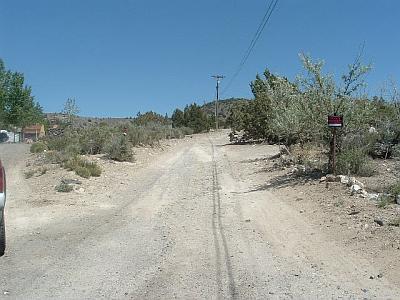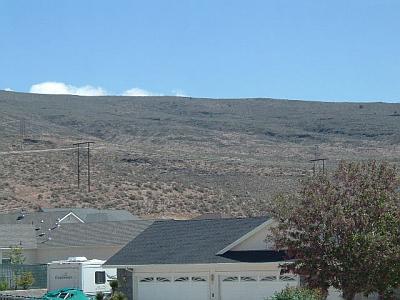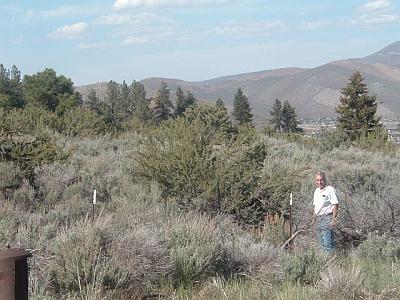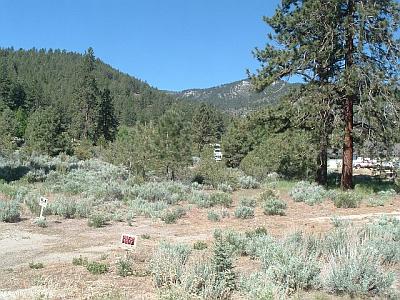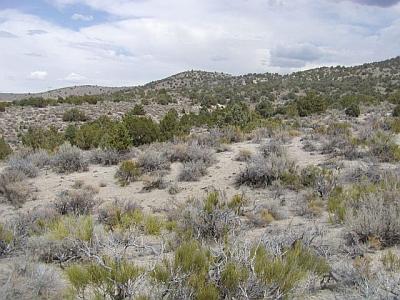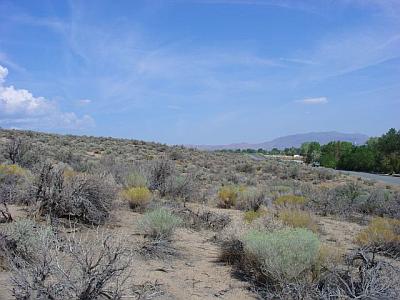5.0 Carson City
5.1 Risk and Hazard Assessment
The Carson City community encompasses all private residential lands within the municipality excluding the Clear Creek subdivision, the Carson Indian Colony, and Stewart. The City is situated in the Eagle Valley basin with hills facing all aspects. Carson City is bordered to the north by Washoe County, to the east by the Pine Nut Mountains and Lyon County, and to the south by Douglas County. The City is dissected north-south by US Highway 50 and east-west by US Highway 395. The Carson City Municipality has an estimated population of 55,220 persons (Nevada State Demographer 2003).
The risk/hazard assessment resulted in classifying the Carson City community in the Moderate Hazard category (53 points). A summary of the values that affect the hazard rating is included in Table 5-2. The moderate hazard condition is attributed primarily to the relatively flat terrain around most homes in the community, the availability of fire suppression resources in the event of a wildfire, multiple access routes around the community, fuel reduction treatments around some subdivisions, and defensible space around structures in many interface areas. However, Carson City is a large community and some of the smaller neighborhoods and subdivisions would likely fall into the high or extreme hazard categories if assessed separately. The specific findings for each of the wildland fire assessment factors are discussed below.
5.1.1 Community Design
The area surrounding the Carson City community was considered both classic interface and intermixed wildland-urban interface conditions. The classic interface condition occurs where there is a clear line of demarcation between structures and wildland fuels and wildland vegetation typically does not continue into the developed areas. The intermix condition includes structures scattered throughout the wildland area with no clear line of demarcation between wildland fuels and residences in the community.
Within the Carson City community interface, approximately 68 percent of the homes are on lots less than one acre in size, and 32 percent of the lots are between one and ten acres in size. As such, most structures are spaced close together, though a few structures are surrounded by sizeable expanses of vacant land (see Figure 5-1).
- Access: US Highway 50 and US Highway 395 are the major transportation routes linking the Carson City community to surrounding communities. There are several other State Routes and major secondary roads that provide access to developed areas. These primary access roads are all at least 24 feet wide, paved and have adequate turnaround space for fire suppression equipment. No dead-end roads pose turn around hazards for fire suppression equipment in the interface areas. A majority of roads in the community have less than a five percent gradient. Only one access road serves each of the Timberline, Kings Canyon, and Mexican Dam neighborhoods.
- Signage: Street signs were present and visible for all streets. Residential addresses were generally visible except in the Lakeview and Pinyon Hills areas where the larger lots make it difficult to see addresses from the roads. Clear and visible signage throughout the Carson City community assists fire suppression personnel in locating residences during poor visibility conditions that may occur during a wildland fire.
- Utilities: The utilities serving the Carson City community are a combination of above ground and below ground utilities. Most of the power line rights-of-ways have been properly maintained to minimize the potential of either ignitions from sparks during windstorms or exploding transformers during peak electricity use periods. The Pinyon Hills area is in need of vegetation clearing and thinning around power lines.
5.1.2 Construction Materials
Of the 1,244 homes observed in the interface area, almost all were built with treated wood siding materials, stucco, vinyl, brick or other fire resistant siding materials. Most homes had fire resistant roofing materials such as composite roofing, metal, or tile. Less than ten percent of the homes observed had an unenclosed balcony, porch, deck, or other architectural features that create drafts and provide areas where sparks and embers can lodge, smolder, and ignite, rapidly spreading fire to the home.
5.1.3 Defensible Space
Approximately 75 percent of homes observed had landscaping that would meet defensible space guidelines to protect the home from damage or minimize loss during a wildfire. Areas of the Carson City community where defensible space was not always adequate included lots in the Pinyon Hills area and lots larger than one acre east of Edmonds Drive.
5.1.4 Suppression Capabilities
The Carson City Fire Department and Sierra Forest Fire Protection District are responsible for wildfire and structure fire protection within the Carson City community. The Bureau of Land Management and US Forest Service also provide fire protection to the Carson City community for the publicly administered lands surrounding the community. See Tables 4-2 and 4-3 for more information on fire suppression capabilities for initial attack of wildland-urban interface fires.
5.1.5 Factors Affecting Fire Behavior
Vegetation, fuels, and topography contribute to the potential fire hazard around wildland-urban interface communities. The fuel hazards were mapped for the Carson City community and fuel hazard photos were taken to illustrate the relationship between vegetation types, slope, aspect, and overall fuel hazard (see Figures 5-2 and 5-3). The fuel hazards in the vicinity of the Carson City community were mapped prior to the 2004 Waterfall Fire and subsequently revised to reflect the most recent fuel hazard conditions. The fuel hazard is low in the burned areas following the Waterfall Fire due to the lack of vegetation. Rehabilitation and revegetation treatments have been proposed for treating the burned areas, and if successful, will result in low to moderate vegetative fuel density within the next five to ten years.
The vegetative fuel density ranged from moderate to heavy in the Carson City community interface areas. Dominant vegetation types around The Carson City community included sagebrush/bitterbrush, sagebrush/perennial grass, sagebrush/pinyon/juniper, and Jeffrey Pine/bitterbrush associations. Fuels in the unburned southwest portions of the Carson City community from Voltaire Canyon north to Kings Canyon consisted primarily of bitterbrush, big sagebrush, desert peach, and cheatgrass. Shrub heights ranged between two and five feet, the fuel load was four to five tons per acre and was considered a high fuel hazard.
In the unburned areas near Kings Canyon, the dominant vegetation consisted of a Jeffrey pine and white fir tree canopy with an understory of big sagebrush and bitterbrush. The fuel load was classified as heavy with shrub heights between five and six feet, an estimated fuel load of eight tons per acre, which is a high fuel hazard. However, due to the Waterfall Fire, the fuels were no longer continuous across the landscape in this area.
The unburned vegetation in the interface areas of upper Vicee Canyon and the Timberline and Lakeview subdivisions were considered heavy density fuels with dominant species including a tree canopy of Jeffrey pine and mountain mahogany. Understory species included big sagebrush, bitterbrush, rabbitbrush, perennial grasses, and cheatgrass. Shrub heights ranged from three to five feet, and fuel loads in the area were estimated to be eight tons per acre. Fuels are not continuous in these areas, but still present a high hazard if an ignition occurred within the subdivisions.
On the north side of the community, north of Bonanza Lane, the moderate density fuels were predominantly composed of bitterbrush, big sagebrush, Mormon tea, rabbitbrush, and desert peach with a cheatgrass understory. The distance between shrubs was approximately three feet with shrub height ranging from two to four feet. The fuel load in this area was estimated at two tons per acre and considered a high fuel hazard.
On the northeast side of the community, north of Arrowhead Road, the fuel density was light dominated by short and widely spaced sagebrush, rabbitbrush, and desert peach shrubs. Previous fires have burned in this area and there was an understory of cheatgrass. The fuel load was estimated at one ton per acre and considered a low fuel hazard.
Fuel density was heavy on the east side of the Carson City community near the Pinyon Hills subdivision. Pinyon and juniper trees were spaced ten to thirty feet between crowns with an understory of sagebrush, bitterbrush, Mormon tea, rabbitbrush, and spiny hopsage. Indian ricegrass, cheatgrass, and pinyon and juniper duff comprised the ground fuels in the area. Fuel loads were estimated to range between six and thirteen tons per acre depending upon tree density. The variable tree densities resulted in a fuel hazard of moderate to high in the areas of close proximity to homes.
Fuels in the southeast area of the community near the large parcels in the Mexican Dam area consisted of bitterbrush, big sagebrush, Mormon tea, desert peach, and rabbitbrush with an understory of cheatgrass. A few scattered pinyon pine trees were present on the east side of this area. Fuel height generally ranged between two and four feet with moderate density fuel loads of three to four tons per acre. The fuel hazard in the area ranged from low to moderate depending upon the presence of riparian vegetation (low hazard) and the shrub density.
Fuels around the Prison Hill area east of Edmonds Drive were dominated by big sagebrush and rabbitbrush with an understory of cheatgrass, annual mustard, and Russian thistle (tumbleweeds). The average fuel load in the area was three to four tons per acre and was considered a moderate fuel hazard.
The terrain along the west, north, and east sides of the Carson City community is fairly steep (20 to 40 percent slopes) with several east/west directional canyons along the hillsides. Slopes on the south side of the community are slightly less steep ranging from five to twenty percent. The predominant wind direction is from the south-southwest in the late afternoon, with occasional strong downslope winds in the late afternoons during the summer months. There is a history of lightning strikes west, north, and east of the community.
5.1.6 Previous Fire Hazard Reduction Projects
Efforts have been made by various agencies to create defensible space and implement fuel reduction projects throughout the Carson City community. Figures 3-3, 5-1, 5-4, and 5-5 illustrate the locations of various wildland-urban interface projects that have either been implemented, are scheduled to be completed in 2005, or are planned and awaiting future funding. Fuels treatment projects completed to date have been 100 to 300 feet wide; have been drill or broadcast seeded with grass species adapted to the area; and have included (Plateau®) herbicide treatment where allowed and necessary to reduce competition from cheatgrass. The fuels reduction treatment areas were created utilizing mechanized mastication equipment and hand crews to thin and remove brush and prune trees.
The Nevada Division of Forestry has awarded grants to the Carson City Fire Department, Fire Prevention Division to implement fuel reduction and defensible space projects. With the assistance of NDF Conservation Camp crews, defensible space treatments have been completed on approximately 80 percent of the homes in the Lakeview subdivision and on about 80 percent of the exterior lots in the Timberline subdivision. Other agencies cooperating with Carson City Fire Department include the USFS Carson Ranger District, BLM Carson City Field Office, and the Nevada Fire Safe Council (Giomi pers. comm.).
The USFS Carson Ranger District completed two fuelbreaks in 2004 on the west side of the Lakeview subdivision. These 400-foot wide fuelbreaks were approximately 25 acres in size and involved reducing brush cover to levels between twenty and fifty percent. The USFS also thinned trees in a five acre plantation near the southwest corner of the Lakeview subdivision.
The BLM Carson City Field Office completed a 2.5-mile, 100-foot wide wildland-urban interface fuel reduction treatment on the east side of homes in the Prison Hill Area in June 2002 (east of Edmonds Drive) (see Figure 3-3). The BLM Carson City Field Office and Carson City Fire Department are cooperatively planning a four mile, 150 to 200-foot wide fuel reduction treatment on the east side of the Pinyon Hills area (Deer Run treatment area) of Carson City for January 2005 (Figure 5-4). Both agencies are also planning to complete 43 acres of fuel reduction treatment for the northeast and south portions of the Mexican Dam area in January 2005 (Figure 5-5). The BLM Carson City Field Office also maintains several small fuel reduction treatments around structures at the Silver Saddle Ranch (Roide pers. comm.).
The University of Nevada Cooperative Extension (UNCE) received a grant to implement a fuelbreak along C-Hill on the west side of Carson City in 1999. The project involved utilizing concentrated sheep grazing to reduce the grass fuels and create a 2.5-mile fuelbreak, 150 to 200 feet wide. Fine fuels were reduced by 0.75 to 2.75 tons per acre. The fine fuels were significantly reduced for two growing seasons, but grazing would need to be repeated every two to three years to maintain the fuelbreak. On the ground implementation, combined with public education, resulted in high homeowner acceptance and approval for this fuel reduction method.
5.1.7 Fire Behavior Worst-Case Scenario
The worst-case wildfire scenario for a major wildland fire in the area surrounding the Carson City community would likely occur in the event of a dry lightning storm with numerous ignitions on the east side of the City. Fire agencies could be faced with several major fires being pushed by erratic winds toward residential areas on the east side of Carson City. A fire ignition located either south of the Mexican Dam area or south of the Pinyon Hills area on the west-facing slope of the Pine Nut Range, pushed by strong 25 to 30 mile per hour south or southwest winds, could spread rapidly toward either the Mexican Dam or Pinyon Hills areas of the community. The intermix interface condition and moderate to heavy fuel density in this area could increase the difficulty of controlling a wildfire threatening homes. The scenario would be worsened if mutual aid resources were unavailable or limited due to assignment of an emergency situation elsewhere.
5.1.8 Ignition Risk Assessment
The Carson City community has a high ignition risk rating. There is a significant history of wildfire and fire ignitions in the public lands surrounding the community. High ignition rates are due to the moderate density fuel in and around the community, the tendency for lightning storms during the summer, and number of recreationists using the wildlands near the community. Ignition risks fall into two categories - lightning and human caused. Human caused ignitions can come from a variety of sources: fires started along highways and roads from burning material thrown out of vehicle windows, ignitions from auto accidents, off-road vehicles, faulty power lines, ditch burning, debris burning in piles or burn barrels, matches, target shooting, and fireworks. In Carson City, ignitions have been caused almost equally by both human causes and lightning.
5.2 Risk and Hazard Reduction Recommendations, Roles, and Responsibilities
The Carson City community risk and hazard reduction recommendations address the primary concern regarding protection of existing and future development in the wildland-urban interface area. Other recommendations pertain to community coordination and public education efforts that would enhance fire safety in the Carson City community.
5.2.1 Defensible Space Treatments
Defensible space is an essential first line of defense for residential structures. Significantly reducing or removing vegetation within a prescribed distance from structures (a minimum of 30 feet to 200 feet depending upon slope and vegetative fuel type) reduces fire intensity and improves firefighter and homeowner chances for successfully defending a structure against oncoming wildfire.
Property Owner Responsibilities
- Remove, reduce, and replace vegetation to create defensible space around homes according to the guidelines in Appendix F. This area should be kept:
- Lean: There are only small amounts of flammable vegetation, and
- Clean: There is no accumulation of dead vegetation or other flammable debris, and
- Green: Existing plants are healthy and green during the fire season.
- Remove debris and flammable materials from within the defensible space area.
- Store firewood a minimum distance of thirty feet from structures.
- Mow or remove brush growing against wood fences in the community.
- Pine needles, leaves, and debris should be removed from roofs and rain gutters.
- Maintain areas under wood decks and porches free of weeds and other flammable debris.
- Clear all vegetation and combustible materials around propane tanks for a minimum distance of ten feet.
- Spark arrestors should be installed on chimneys.
- Maintain a minimum clearance of thirty feet from the crown of trees that remain within the defensible space zone. Keep this area free of smaller trees, shrubs, and other ladder fuels.
- Trim and remove tree branches a minimum of five feet or one-third the height of the tree from the ground for Jeffrey Pine and other large conifers and a minimum of two feet (or one-third the height) from the ground for pinyon and juniper trees to reduce ladder fuels within the defensible space zone. Prune all dead and diseased branches. Remove flammable material including duff from beneath crowns of retained trees.
- Prune trees so that the branches are at least fifteen feet away from chimneys and or structures.
- Immediately dispose of cleared vegetation when implementing defensible space treatments. This material dries quickly and poses a fire hazard if left on site.
- Maintain defensible space as needed to keep the area lean, clean, and green.
5.2.2 Fuel Reduction Treatments
In conducting the risk and hazard assessment for the Carson City community, the RCI Project Team Fire Specialists reviewed the fuelbreaks proposed and previously implemented by Carson City Fire Department, Bureau of Land Management, US Forest Service, and Nevada Division of Forestry. RCI concurs with the need for the planned fuelbreaks in the community. These planned fuelbreaks will reduce fire spread rates and increase firefighter safety in the event of a wildland-urban interface fire.
There are several areas within the Carson City community in which reducing vegetation along roadways and driveways could reduce the likelihood of wildfire spreading across roads, as well improve firefighter access and safety for protecting homes. The areas of most concern for removing vegetation along roads include the Pinyon Hills, Mexican Dam, Lakeview, Kings Canyon, Timberline, and Voltaire Canyon areas.
Carson City Fire Department, Bureau of Land Management, Nevada Division of Forestry, US Forest Service, and Washoe Tribe Responsibilities
- Pursue funding for and implement the planned and scheduled fuelbreaks and fuel reduction treatments for the Carson City community (Figures 5-1, 5-4 and 5-5).
Nevada Department of Transportation and Carson City Street Department Responsibilities
- Reduce vegetation in wildland-urban-interface areas of the Carson City community, and continue vegetation maintenance along road shoulders for a distance of twenty feet from the edge of the roadway on both sides. Vegetation should be mowed to a height of no more than four inches. The biomass should be removed and disposed of at an appropriate site.
Property Owner Responsibilities
- Reduce fuels at least ten feet along both sides of private driveways that are longer than 200 feet. Flammable fuels should be replaced with fire-resistant species such as crested wheatgrass, irrigated deciduous shrubs, wildflowers, and lawn or by seeding with an approved pre-suppression seed mix. Refer to Appendix F for approved seed mixes, planning guidelines, and seed sources.
Nevada Department of Transportation and Carson City Street Department
- For the areas of Lakeview, Pinyon Hills, Kings Canyon, Voltaire Canyon, and Timberline, reduce vegetation and continue vegetation maintenance along road shoulders for a distance of twenty feet from the edge of roadway on both sides of the road. Vegetation should be mowed to a height of no more than four inches. The biomass should be removed and disposed of at an appropriate site.
- Avoid grading road shoulders to expose bare soils and create conditions conducive to invasion of cheatgrass and other noxious weeds.
- Maintain a minimum clearance of fifty feet along existing fences in the undeveloped freeway bypass right-of-way.
Mexican Dam Homeowner’s Association Responsibilities
- Reduce vegetation and continue vegetation maintenance along road shoulders within the Mexican Dam neighborhood for a distance of twenty feet from the edge of roadway on both sides. Vegetation should be mowed to a height of no more than four inches. The biomass should be removed and disposed of at an appropriate site approved by the Carson City Fire Department.
Electric Utility Company Responsibilities
- Clear all shrubs and maintain a minimum clearance distance of thirty feet from the fence around the transformer station in Voltaire Canyon. Reduce vegetation to maintain a minimum distance of fifteen feet from all utility poles.
5.2.3 Community Coordination
Many of the most effective activities aimed at reducing the threat of wildfire for the Carson City community require that individual property owners coordinate with each other and with local fire authorities. Defensible space, for example, is more effective in small communities when applied uniformly throughout entire neighborhoods. Public education and awareness, neighbors helping neighbors, and proactive individuals setting examples for others to follow are just a few of the approaches that will be necessary to meet the fire safe goals in the community. Disposal of biomass generated from defensible space and fuel reduction treatments can sometimes be most efficiently handled through community programs.
Property Owner Responsibilities
- Form local chapters of the Nevada Fire Safe Council in areas of the Municipality such as Timberline, Lakeview, Kings Canyon, Pinyon Hills, Mexican Dam, and North Carson. The Nevada Fire Safe Council proposes to work on solutions that reduce the risk of loss of lives and property from wildfires in Nevada’s communities. Through establishment of a local Chapter, communities become part of a large information-sharing network that receives notifications of programs and funding opportunities for fire mitigation projects such as those listed in this report. The Nevada Fire Safe Council will accept and manage grants and contracts on the Chapter’s behalf through its non-profit status. The Nevada Fire Safe Council provides assistance and support to communities to complete fire safe plans, set priorities, educate and train community members, and promote success stories of its members. For more information on forming a chapter, contact:
Nevada Fire Safe Council
1187 Charles Drive
Reno, Nevada 89509
www.nvfsc.org - Assure that residential addresses are visible from the road. Address characters should be at least four inches high, reflective, and composed of non-flammable material. Improving visibility of addresses will make it easier for those unfamiliar with the area to navigate an area under smoky conditions in the event of a wildland fire.
5.3 Summary of Recommendations
| Responsible Party | Recommended Treatment | Recommendation Description |
|---|---|---|
| Property Owners | Defensible Space Treatments | Remove, reduce, and replace vegetation around homes according to the guidelines in Appendix F. Maintain defensible space as needed to keep the space lean, clean, and green. |
| Fuel Reduction Treatments | Reduce fuels at least ten feet along both sides of private driveways that are longer than 200 feet. | |
| Community Coordination | Form local chapters of the Nevada Fire Safe Council. Improve address visibility. |
|
| Carson City Fire Department, Bureau of Land Management, Nevada Division of Forestry, US Forest Service, and Washoe Tribe | Fuel Reduction Treatments | Pursue funding for and implement the planned and scheduled fuelbreaks and fuel reduction treatments for the Carson City community (Figures 5-1, 5-4 and 5-5). |
| Nevada Department of Transportation | Fuel Reduction Treatments | Reduce vegetation and continue vegetation maintenance along road shoulders for the Lakeview, Pinyon Hills, Kings Canyon, Voltaire Canyon, and Timberline areas of the Carson City community. |
| Mexican Dam Homeowners Association | Fuel Reduction Treatments | Reduce vegetation and continue vegetation maintenance along shoulders on both sides of the road within the Mexican Dam neighborhood. |
| Electric Utility Company | Fuel Reduction Treatments | Clear all shrubs and maintain a minimum clearance of thirty feet from the fence around the transformer station in Voltaire Canyon. Reduce vegetation to maintain a minimum distance of fifteen feet from all utility poles. |
Table 5-2Carson City Wildfire Hazard Rating Summary |
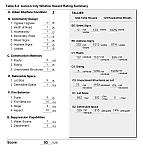 |
Figure 5-1Carson City Community Suppression Resources, Critical Features, Fire History, and Proposed/Planned Mitigation Projects |
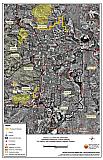 |
Figure 5-2Carson City Community Classification of Fuel Hazard |
 |
Carson City Community Fuel Hazard Photo Points
Photo Point 1. Carson City Fuel Hazard Photo Point. 4343040N, 260709E, 20°NE. The fuels north of Bonanza Road in northern Carson City were primarily sagebrush, bitterbrush, Mormon tea, rabbitbrush, and desert peach. Shrubs were spaced about three feet apart, fuel loads estimated at two tons per acre, and considered a high fuel hazard.
Photo Point 2. Carson City Fuel Hazard Photo Point. 4336992N, 266958E, 95°SE. In the Pinyon Hills area of Carson City, the fuels were characterized by a pinyon-juniper tree layer with a sagebrush and bitterbrush understory. The fuel load was estimated at six tons per acre and considered a moderate fuel hazard.
Photo Point 3. Carson City Fuel Hazard Photo Point. 4344241N, 263185E, 60°NE. On the northeast side of Carson City near Goni Road, previous fires in the area have reduced the fuel load to one ton per acre or less. Fuels included sagebrush, rabbitbrush, and desert peach, spaced three feet apart, and considered a low fuel hazard.
Photo Point 4. Carson City Fuel Hazard Photo Point. 4337488N, 256930E, 300°NW. Prior to the 2004 Waterfall fire, the fuel load in the King’s canyon area was estimated at eight tons per acre. Vegetation was composed of sagebrush, bitterbrush, Jeffrey pine, and white fir. The photo point represents pockets of remaining unburned vegetation in the area, which are considered a high fuel hazard.
Photo Point 5. Carson City Fuel Hazard Photo Point. 4342525N, 257516E, 274°NW. Vegetation in the Vicee Canyon and Timberline areas prior to the Waterfall Fire consisted of Jeffrey pine, bitterbrush, sage, rabbitbrush, and some cheatgrass. Fuels were estimated at eight tons per acre and considered a high fuel hazard.
Photo Point 6. Carson City Fuel Hazard Photo Point. 4332186N, 266763E, 0°N. In the Mexican Dam area of Carson City, fuels consisted primarily of sparse pinyon-juniper, with two to four foot tall sagebrush and rabbitbrush in the understory. The fuel load was estimated between three and four tons per acres and considered a moderate fuel hazard.
Photo Point 7. Carson City Fuel Hazard Photo Point. 4336251N, 266709E, 45°NE. The moderate to high density pinyon and juniper canopy cover represents a high fuel hazard in the area east of Pinyon Hills. In these areas the fuel load was estimated to be 13 tons per acre.
Photo Point 8. Carson City Fuel Hazard Photo Point. 4331833N, 261240E, 345°N. In the Rabe Way area of Carson City, fuels consisted primarily of sagebrush, bitterbrush, rabbitbrush, desert peach, and Mormon tea. The fuel hazard in this area was high.
Figure 5-4BLM Carson City Field Office and Carson City Fire Department Scheduled Fire Mitigation Projects for the Pinyon Hills Area |
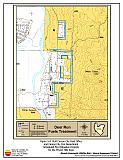 |
Figure 5-5BLM Carson City Field Office and Carson City Fire Department Scheduled Fire Mitigation Projects for the Mexican Dam Area |
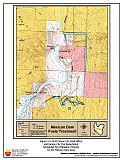 |


